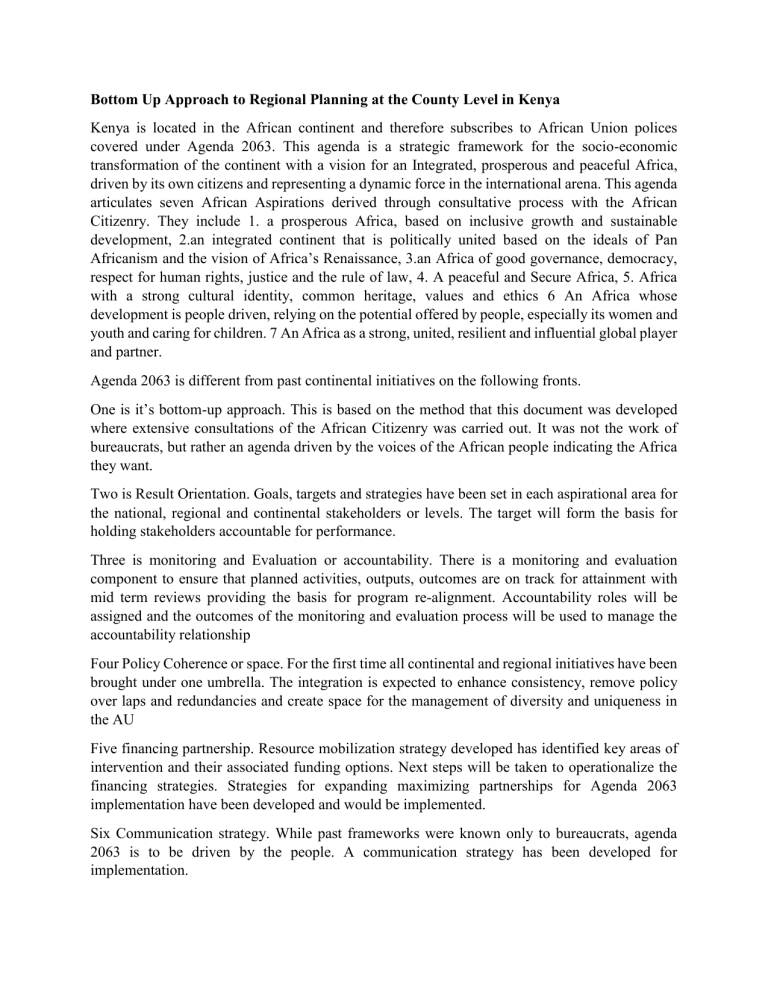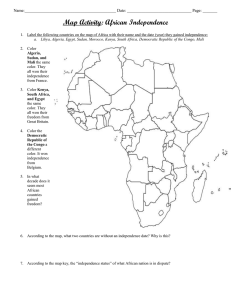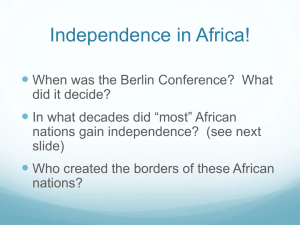
Bottom Up Approach to Regional Planning at the County Level in Kenya Kenya is located in the African continent and therefore subscribes to African Union polices covered under Agenda 2063. This agenda is a strategic framework for the socio-economic transformation of the continent with a vision for an Integrated, prosperous and peaceful Africa, driven by its own citizens and representing a dynamic force in the international arena. This agenda articulates seven African Aspirations derived through consultative process with the African Citizenry. They include 1. a prosperous Africa, based on inclusive growth and sustainable development, 2.an integrated continent that is politically united based on the ideals of Pan Africanism and the vision of Africa’s Renaissance, 3.an Africa of good governance, democracy, respect for human rights, justice and the rule of law, 4. A peaceful and Secure Africa, 5. Africa with a strong cultural identity, common heritage, values and ethics 6 An Africa whose development is people driven, relying on the potential offered by people, especially its women and youth and caring for children. 7 An Africa as a strong, united, resilient and influential global player and partner. Agenda 2063 is different from past continental initiatives on the following fronts. One is it’s bottom-up approach. This is based on the method that this document was developed where extensive consultations of the African Citizenry was carried out. It was not the work of bureaucrats, but rather an agenda driven by the voices of the African people indicating the Africa they want. Two is Result Orientation. Goals, targets and strategies have been set in each aspirational area for the national, regional and continental stakeholders or levels. The target will form the basis for holding stakeholders accountable for performance. Three is monitoring and Evaluation or accountability. There is a monitoring and evaluation component to ensure that planned activities, outputs, outcomes are on track for attainment with mid term reviews providing the basis for program re-alignment. Accountability roles will be assigned and the outcomes of the monitoring and evaluation process will be used to manage the accountability relationship Four Policy Coherence or space. For the first time all continental and regional initiatives have been brought under one umbrella. The integration is expected to enhance consistency, remove policy over laps and redundancies and create space for the management of diversity and uniqueness in the AU Five financing partnership. Resource mobilization strategy developed has identified key areas of intervention and their associated funding options. Next steps will be taken to operationalize the financing strategies. Strategies for expanding maximizing partnerships for Agenda 2063 implementation have been developed and would be implemented. Six Communication strategy. While past frameworks were known only to bureaucrats, agenda 2063 is to be driven by the people. A communication strategy has been developed for implementation. Seven Capacity. A key success factor for the successful implementation of Agenda 2063 is the capacity of individuals and instructions to play their roles in the domestication of the Agenda. A Capacity Assessment Study is being undertaken to address the capacity needs of continental and regional institutions. This will later be extended to member states Retrieved from https://au.int/agenda2063/about on 3, April 2019. Websit. Continental Free trade Areas CFTA aspires to liberalize trade between African countries across the continent and to build on consideratble successes already achieved within Aarica’s regional economic communities An ambitious initiative for the world’a second-largest continent CFTA comprises the 55 member states of the AU and 8 AU-recognized Regional Economic Communities with varying trade liberalization legal framework. The REC are East African Community, Arab Maghreb Union AMU, Economic Community of West African States ECOWAS, Intergovernmental Authority on Development IGAD, Southern African Development Community SADC, Common Market for Eastern and Southern African COMESA, Economic Community of Central African States ECCAS, and the Community of Sahel-Saharan States CEN-SAD. Kenya is found within the East African Community but is also a member of other Regional Economic Communities such as COMESA, IGAD and CEN-SAD. This means that regional policies and goals need to align to all the Regional Economic Communities Kenya is party to in order to achieve the aspirations of Agenda 2063. National Level At the National level, Kenya also has a National Policy called vision 2030 which aims to transform Kenya into a middle income nation by 2030. Vision 2030 is further broken down into five years’ medium term plans starting making it now to be at the third medium term plan of 2018-2022. Within the same vision 2030 plan are various sectoral plans produced after every five years. In the end what you have is several plans within the same sector. For example, in the case of tourism development which is considered one of the key sectors under the economic pillar of vision 2030, it has to align its plans to the medium term plans and the sectoral plans. It is important to remember that Kenya had its first Tourism Act in 2011 which also prescribes five-year Master Plans for tourism development. This is not a bad thing at all given the concerted effort to support tourism sector which was neglected for a very long time. What is paramount considering the existence of all these plans is the they must find a way to achieve the same objectives and ensure that duplication of activities is avoided. Regional Level Kenya is again sub-divided into 47 autonomous counties which are headed by the Governors. They have their own county assemblies where elected County Representatives meet to discuss the county budget and to pass by-laws. These counties have their own master plans and policy initiatives mostly spearheaded by the governors during their electioneering period. Bottom up approach to planning at the County Level Bottom up is one of the approaches to planning that allows the local community and local players to express their views and to help define the development course for their area in line with their own views, expectations and plans. As the name suggests, it literally refers to planning that incorporates opinions of people who are at the local level concerning their needs and priorities relating to development and then escalating it up reach officials who give approval for implementation. It is the bridge between the grass and the tall towers in which government officials sit in. It is due to this principle of subsidiarity that bottom up approach is enshrined in the Kenya constitution of 2010. The belief is that with it advent of devolution, it is only through bottom up approach to planning that the aspirations of the local communities would be clearly captured at both the county and national government levels. However, it is important to appreciate the fact that bottom up approach cannot be applied systematically to all places in all circumstances. For instance, most regions in Kenya which need development are the rural and marginalized regions where illiteracy levels are also quite high. Most of the communities in these regions such as Turukana are also nomadic pastoralists which means that getting them to participate in decision making is almost impossible. In cases where they are available it is also difficult for them to making meaningful contribution to technical aspects such as the oil exploration that is being carried out in their regions. A part from that, middle class which comprises the learned in Kenya to together with members from academia have also been accused of exhibiting disinterest when it comes to public participation process. The county government officials have from time to time lamented that every time they invite the public to attend various sittings intended to give their views it is very few people who turn up. As a result, the county assembly is forced to make decisions on behalf of the public without factoring in the most important issues to be addressed at the grassroots level. Although there is another school of thought for the public which holds the view that politicians are never to be trusted and that most projects they initiate for their own shellfish interest as opposed to public interest. Therefore, attending those public meetings is a waste of time given that they will rarely implement the views that the public offer. This means that for bottom up approach to work well, the policy makers must seek to capture very clearly the opinions of the locals and to implement them guided by technical revisions. It is only through this that public will begin to take These consultative sessions seriously. Otherwise it will be same old trend of paying lip service to local development only to appear during electioneering period requesting re-election in order to complete the projects with nothing to show for it. Bottom Up planning at the County Level Revenue sharing Sources of revenue Population and size Neighboring counties doing well Disinterest





